What, Exactly, Is Arrachera Steak?
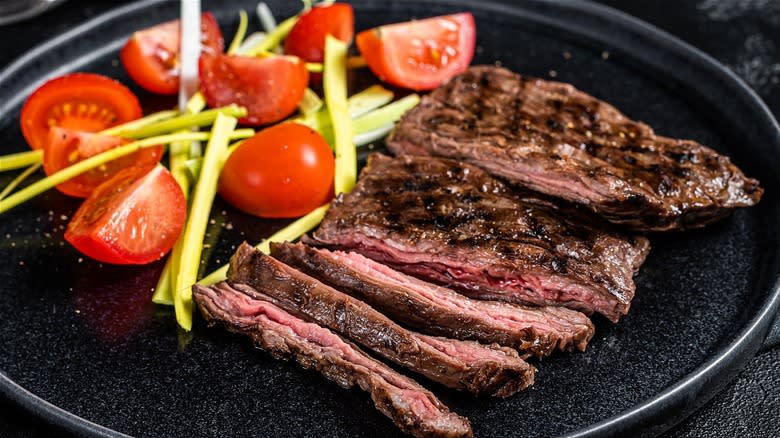
If you are unfamiliar with the term "arrachera steak" –- or any [insert unknown name] steak, for that matter -- you may be unsure as to whether the "arrachera" (or other unknown name) refers to a particular cut of meat or else to a particular style of preparation. Delmonico steak, after all, is a type, while steak au poivre is a recipe (and Salisbury steak isn't any kind of steak at all but simply a dressed-up hamburger). Arrachera, despite the numerous recipes online specifying its use in Mexican recipes, is actually a cut.
As to what specific type, that's where things get tricky. According to Collins Dictionary, the word "arrachera" is Spanish for "hanger steak." Google Translate, however, begs to differ. In its not-so-humble opinion, the Spanish translation is "skirt steak." (Interestingly enough, though, when it is allowed to detect the language, it goes with French and translates the word to mean "will snatch.") So is there a difference between skirt and hanger steaks? Why yes, there is. The former are longer and heavier, while hanger steaks are shorter but wider. Still, as both seem to be accepted under the arrachera umbrella, either one should do for any recipes calling for this type of steak.
Read more: Cuts Of Steak, Ranked Worst To Best
What Is Arrachera Steak?
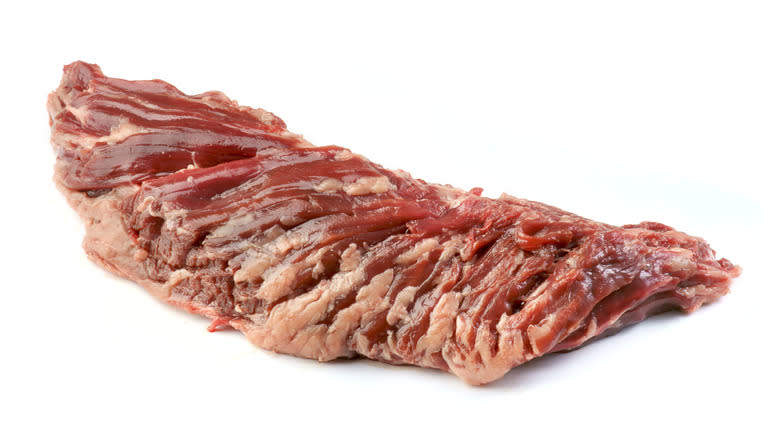
Okay, so several online dictionaries define arrachera as either skirt or hanger steak (or possibly skirt hanger steak, which leads to amusing thoughts of clothing store sales racks where garments are suspended from meat hooks). The confusion doesn't stop here, however, as other sources suggest that it could also be flank steak, as well. Whoa, and we thought defining fajita meat was tough! Fajitas, too, are meant to be made solely with skirt steak, which means there is some overlap between them and arrachera, although by this point the word fajita refers more to a preparation style than an actual cut of meat.
Still, in most cases, when you encounter the term arrachera, it is likely to refer to the type of meat used to prepare carne asada. Arrachera is the beef itself, but when it is seasoned and grilled, it transforms into the latter dish whose name translates (as per Google; we're leaving Collins out of the loop this time) to "roast meat." Carne asada can be made with other types of meat, but beef is by far the preferred one, and skirt steak (arrachera) is the preferred cut. While we typically think of carne asada as a Mexican dish, it's also known in other Latin American countries including Argentina, Brazil, Nicaragua, Paraguay, and Uruguay.
What Does Arrachera Steak Taste Like?
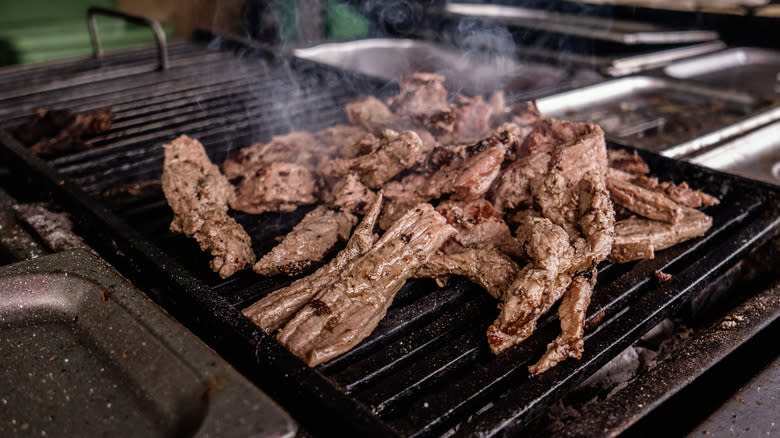
Arrachera steak, whether it be skirt, hanger, or flank, is often described as having a "beefy" taste ... well, duh, steak is by definition beef, so any steak that doesn't taste beefy is cause for concern. As to what differentiates these potential arrachera candidates, skirt steak comes from a well-exercised part of the cow and thus tends to be lean, muscular, and chewy (or possibly tough if you don't cook it correctly). Flank steak, too, is pretty low in fat, so much so that it often needs to be marinated in order to give it some juiciness.
Hanger steak, on the other hand, is also rather lean. The part of the cow it comes from, which is on the underside just above the kidney, is one that those well-versed in bovine anatomy will know doesn't get too much of a workout in the course of a cow's daily routine. This means that despite the lack of marbling, the meat remains quite tender, although some have noted that it can have a slightly metallic taste to it. Still, this is the kind of thing that's easily disguised by the seasonings used in many carne asada recipes.
How To Cook With Arrachera Steak
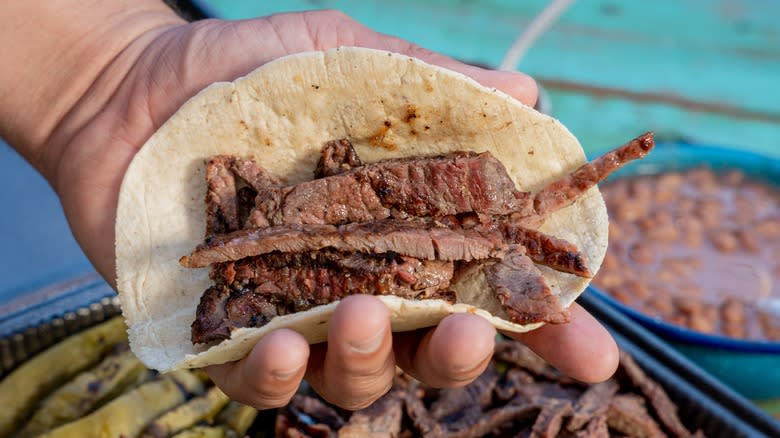
One typical way to cook arrachera steak is to use it in carne asada as previously mentioned. Carne asada, as we know it in the U.S., is typically served in the form of tacos. To make these, you might start by marinating the meat (which is especially advisable if it's a potentially tougher type like skirt of flank steak), perhaps in a mixture of chiles, garlic, and lime juice. You'll then grill it, slice it, wrap it in a tortilla, and top it off with taco stuff like salsa, cilantro, and more chiles.
Carne asada tacos aren't the only thing you can do with arrachera steak, of course. You can certainly use it to make fajitas, as it may be an identical cut of meat, after all. You can also just season and grill the steak and eat it sans tortillas and toppings, or you could cut it into cubes and use it as stew beef. Basically, anything you can do with a thinner, flatter steak, be it skirt, hanger, or flank, you can do with arrachera, since, as we've already established, these are one and the same.
Where To Buy Arrachera Steak
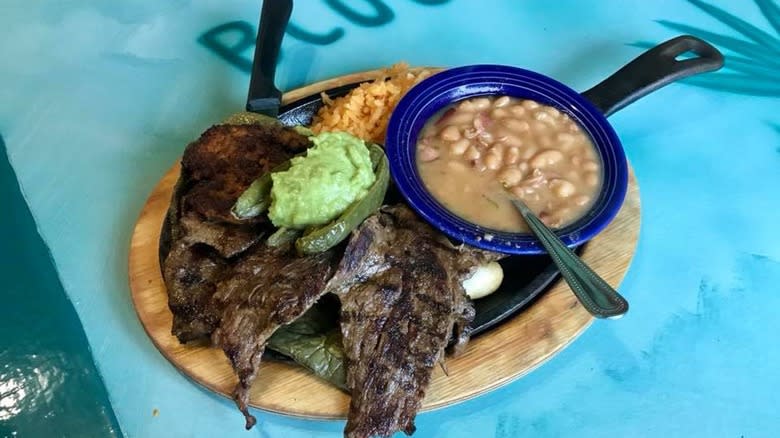
If you want to buy arrachera steak that is labeled as such, you may need to shop at a Latin American food market such as Milwaukee's El Rey Foods or Supermercado Los Corrales in Kenosha, Wisconsin. If you don't mind purchasing this meat under one of its English-language aliases, though, you should be able to find skirt, hanger, and flank steak (or at least one of the three) at most standard supermarkets. Failing that, a more specialized meat market is likely to have them in stock, particularly one billing itself as a carniceria as opposed to a boucherie. At the latter, you might get a bavette steak, though, which is a fancier way of saying flank steak.
Arrachera is something you're also likely to see on the menu of various Mexican restaurants, including Blue Agave Mexican Restaurant in Fletcher, North Carolina; Rojo Cocina Mexicana in Roswell, Georgia; El Chele Restaurant in Moses Lake, Washington; and Dos Reales Mexican Restaurant in Rockford, Illinois. At these establishments, arrachera steak is served as an entree accompanied by beans and rice with maybe some onions, peppers, and salsa. Nebraska's El Potrero Mexican Restaurant chain, however, offers not only an arrachera entree but also has arrachera tacos on its menu.
Nutritional Information About Arrachera Steak
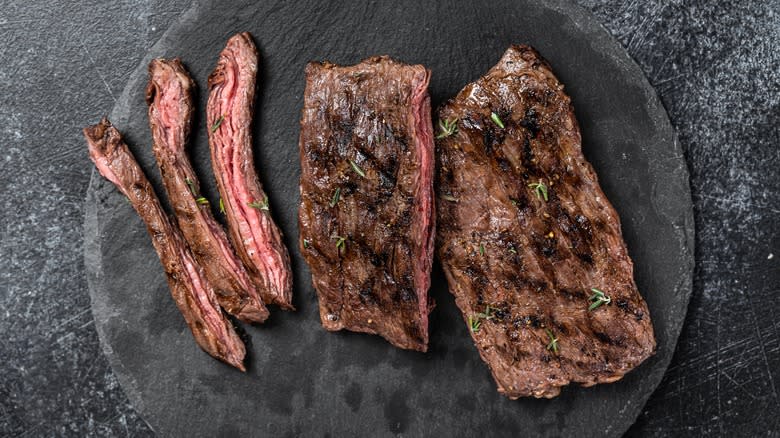
Arrachera steak will have a slightly different nutritional profile depending on whether you are defining it as flank, skirt, or hanger steak. The first of these has 172 calories per 3-ounce serving (which means a more realistic 6 ounces would have 344), while the second has 187, and the heavyweight, hanger steak, packs one more calorie per ounce so has 190 for that same itty-bitty hypothetical 3-ounce serving. These steaks go in the same order when it comes to fat content, as well: flank steak has 8 grams per 3 ounces, while skirt has 10 and the hanger has 12. All three types, however, have zero carbs and zero sugars, at least not until you start adding sauces and marinades and such.
Arrachera, like all other types of steak, is an excellent source of protein. It is also rich in iron and vitamin B12, both of which are good for your blood, and has a decent amount of zinc which can help give your immune system a much-needed boost. The one area in which arrachera (and any steak) gets kind of dicey is when it comes to dietary cholesterol. Flank steak has 69 milligrams in each 3-ounce serving, while hanger steak has 70 milligrams. Skirt steak is your best bet here since it only has 51 milligrams. As a general rule, the University of California San Francisco advises limiting total daily cholesterol consumption to under 300 milligrams (200 if you're at risk of heart disease).
Read the original article on Mashed.

